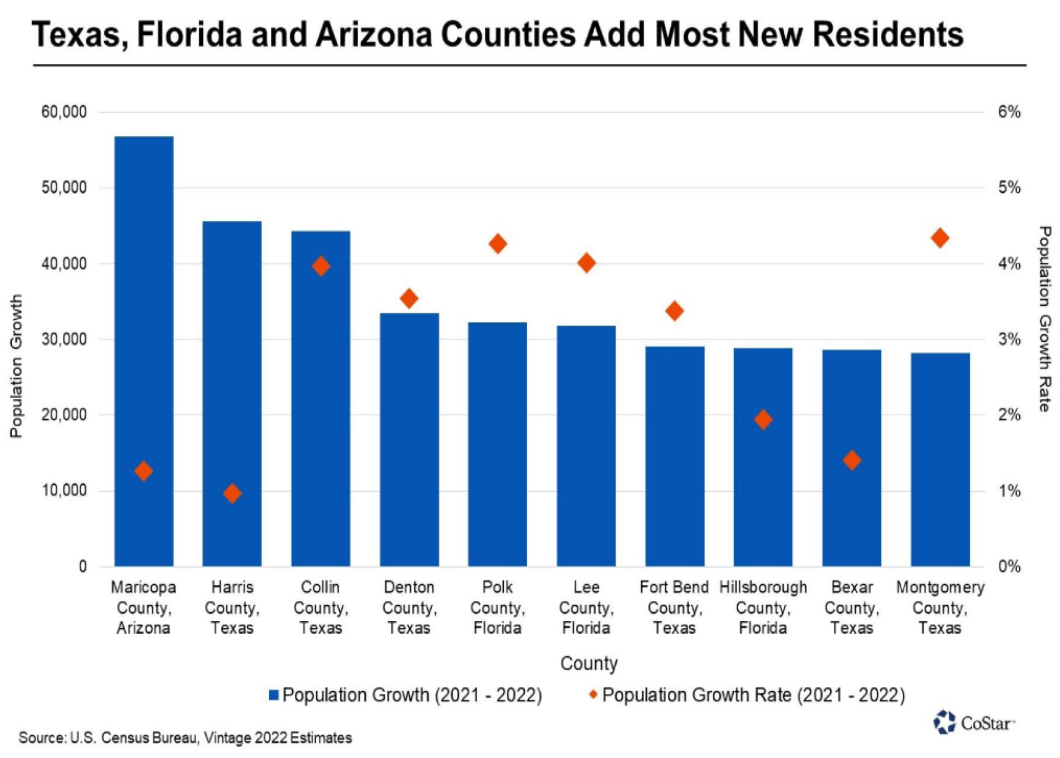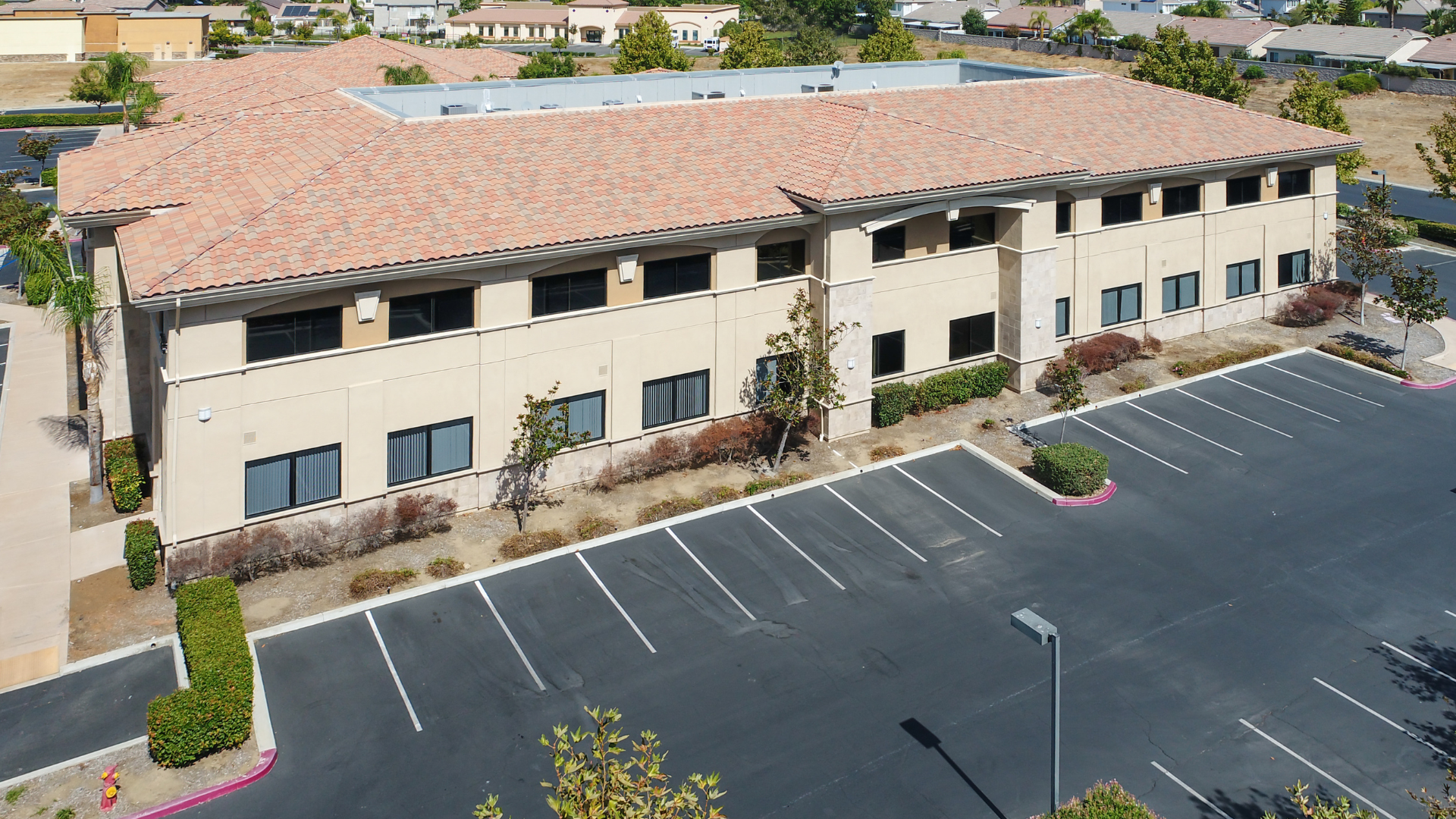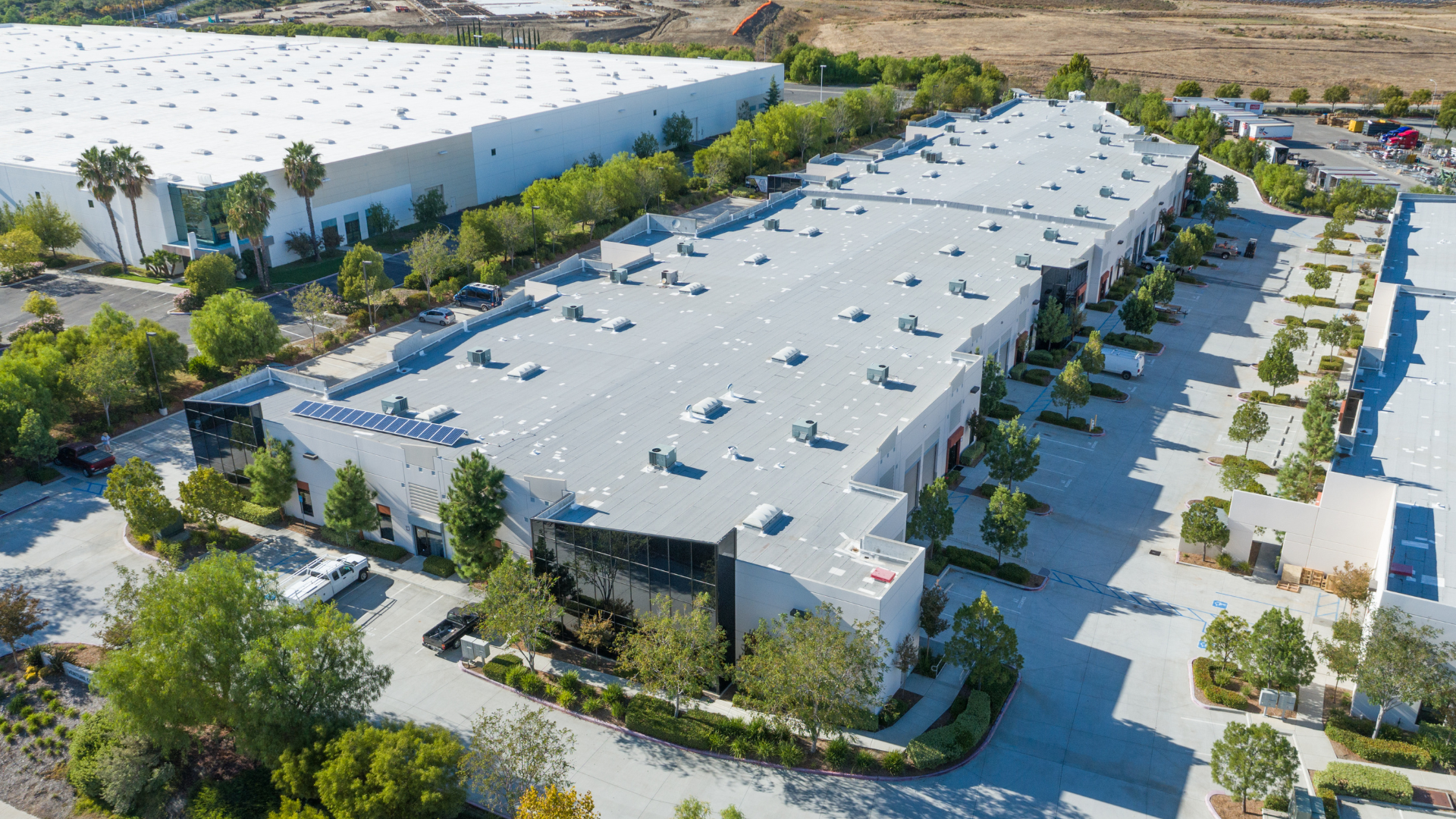Florida’s population has reached a record 23.3 million people, marking one of the fastest growth…

Nine of the 10 Fastest-Growing U.S. Counties Were in Texas and Florida
On a net basis, suburban and urban counties in Texas, Florida and Arizona added the most new residents among all counties across the nation last year. This, according to the recently released Vintage 2022 estimates from the U.S. Census Bureau, is a continuation of a long-standing trend of strong population growth across the Sun Belt.
“Maricopa County once again led the United States in absolute population growth for the third straight year, adding over 56,000 people in 2022,” said Connor Devereux, CoStar’s director of market analytics in Arizona. The county, which comprises the majority of the Phoenix market, boasts a diversified and expanding employment base, attracting job-seeking residents.
The relatively low cost of living and desirable climate encouraged record levels of in-migration, supporting steady underlying demand for Phoenix commercial real estate,” Devereux added.
Multifamily developers have responded to the rapid population growth in the Phoenix area with the largest multifamily construction pipeline on record, which will test the sector in the coming year.
Outside of Arizona, Texas accounted for six of the top 10, with two being urban counties that contain two of the nation’s largest cities: Harris County, home to Houston, and Bexar County, home to San Antonio. The other four Texas counties encompassed the fast-growing suburbs of Dallas-Fort Worth and Houston: Collin, Denton, Fort Bend and Montgomery counties.
Collin and Denton counties remain two of the major engines for population growth in the Dallas-Fort Worth region. Last year, these counties added 44,246 and 33,424 new residents, respectively, driven mostly by in-migration. The two are also home to some of the highest levels of commercial real estate development in the Dallas-Fort Worth area, particularly Collin County.
“Suburbs in these counties, including Plano, Frisco and McKinney, are destinations with their own gravitational pull,” said Bill Kitchens, director of market analytics for Dallas-Fort Worth. “Several factors are drawing new residents including quality of life, more affordable living and well-regarded school districts.”
Kitchens noted that the northern suburbs of the Dallas-Fort Worth metroplex have driven construction activity for multifamily and retail, and have served as a stabilizing force for office demand as well.
Many of the factors that have drawn people to Denton, Frisco, McKinney and Plano have also attracted new residents to suburban Houston. Montgomery County, located just north of Harris, is a high-growth segment of the greater metropolitan area that is home to The Woodlands and Conroe, both of which have posted impressive population gains in recent years.
Fort Bend County is home to Sugar Land, a city just southwest of Houston that is the third-largest municipality in the metropolitan area and a hotspot for real estate development. Fort Bend County is also home to Fulshear, a city that has witnessed incredible population growth over the past 10 years, according to CoStar market analytics director in Houston, Itziar Aguirre.
“Fulshear has expanded its population by more than 20 times over the past decade,” Aguirre said. “Fast-growing suburbs in Houston share similar qualities to those in Dallas, such as more affordable living than the urban core and excellent public schools.”
As for Harris County, Aguirre points to local demographic momentum and international migration to the city of Houston. With more than 4.7 million residents, Harris is the third-most populous county in the United States, just ahead of Maricopa County and its population of 4.6 million.
“The gain was powered by one of the nation’s highest levels of migration from abroad and natural increases,” Aguirre said.
Bexar County, another urban county on the list, is home to the nation’s seventh-largest city: San Antonio. The city and its suburbs added more than 28,000 new residents in one year, and the drivers behind this growth are similar to those behind Phoenix, Dallas and Houston. The recovery in the local job market outpaced the national average between 2020 and 2023, and population growth figures between 2021 and 2022 highlight the continued appeal of San Antonio in the minds of many domestic migrants.
To meet the needs of an expanding population, builders are bringing more than 17,000 multifamily units online in the next couple of years, a record for this traditionally single-family city. Many of the areas with strong residential growth, such as the far west side, New Braunfels, and the Pearl district, are also seeing high levels of investment and development.
Rounding out the top 10 are three counties in Florida, Polk, Lee and Hillsborough Counties. Florida was recently named the fastest growing state in the U.S., with a population increase of 1.9%, or 416,754 new residents, between 2021 and 2022. Out of 60 counties, Polk, Lee and Hillsborough Counties alone accounted for over 20% of the state’s growth.
Much of Florida’s growth is being driven by in-migration from New York, as Florida has been the top relocation state for New Yorkers since 2016. According to the Florida Department of Highway Safety and Motor Vehicles, 65,000 New Yorkers updated their state driver’s licenses to Florida’s in 2022.
It is no surprise that Polk County is the top county people are moving to in Florida over the past two years, as it is sandwiched between two employment hotspots, Orlando and Tampa. The surge in new residents has fueled a multifamily construction boom. Over the past three years 4,700 new units have been completed, with an additional 4,600 currently under construction. Even with elevated new construction, Polk County multifamily rents are significantly lower when compared to Tampa or Orlando, which are 16% and 18% higher, respectively.
Lee County, which is centrally located among the Southwest Florida markets, encompasses Fort Myers and Cape Coral. The county has regularly been a top area people want to live in, and has averaged 610 new residents every week for the past year. The incredible population growth and subsequent demand for housing have pushed employment in the county to record levels. The construction sector accounts for a fourth of all new jobs, which increased 8.4% in February 2023 from a year ago.
Hillsborough County, which contains Tampa, is the fourth-largest county in Florida and home to more than 1.5 million people. Tampa has increasingly been on people’s radar and companies have relocated their corporate headquarters in recent years, including cyber-security company OPSWAT and the packaging company Signode. In addition, pharmaceutical companies Pfizer and AxoGen, as well as identity verification firm ID.me, have all opened significant office operations in the county. The Tampa area has been particularly popular for families, as it is one of only six counties in Florida where births outpace deaths by more than 1,000 people.
Taken together, these trends show that demographic momentum from 2021 did not dissipate in 2022, as Americans continued their historical movement south and west. While many major population centers on the East and West Coast also gained new residents on a net basis last year, the general trend continues to favor the Sun Belt, particularly Texas, Florida and Arizona.
Source: www.costar.com








This Post Has 0 Comments